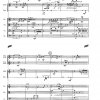Musica concertante
Musica concertante for chamber orchestra (1957–58)
{slider=Musica concertante for chamber orchestra /fragment/}
Silesian Philharmonic Chamber Orchestra, cond. Andrzej Markowski, „Warsaw Autumn” 1958
{/slider}
The work was written as a direct response to the ideas promoted during the International Summer Course for New Music in Darmstadt, in which Serocki took part for the first time in 1957. At that time he found the idea of “treating numbers as a form-creating element” very attractive. However, he remained quite sceptical about the mechanisms of the serial technique, which, in his opinion, were against the laws of perception. In Musica concertante he proposed a solution that was a kind of polemic with the Darmstadt models. The piece – dedicated to Stanisław Wisłocki – was premiered during the Summer Course the following year (1958).
This is how Serocki himself talked about the composition during his 1965 Essen lecture:
The basic idea behind the composition – built of seven short parts, with each part having a different instrumental line-up – is inversion of all parameters, from the smallest formal units to the complete form. [...] Part two is written for piccolo, vibraphone, 5 Chinese blocks and 2 harps. The latter, muffled by a small strip of paper between the strings, bring to mind the timbre of the harpsichord. Part three is composed for a small string ensemble, with the violins, violas, cellos and double basses acting as a string quartet. Part four, played by nearly all instruments (4 brass instruments, 2 harps, the strings and the percussion), constitutes the climax of the work.
The principle of inversion, mentioned by the composer, concerns, in the most general sense, symmetrical relations between the movements located to the left and right of the axis set by the central, fourth movement. In addition, Serocki employs here a well thought-out disposition of the forms of series and their transpositions. The outer parts (first and seventh) contain the original forms (O) and retrogrades (R) of the prime series in various transpositions and reverse order (in p. I: O+R, in p. VII: R+O); parts two and six, similarly – all mirror forms (inversion retrograde (IR) + inversion (I) + R + O and vice versa). Parts three and five contain – respectively – presentations of the inversion retrograde and the inversion, which are their mutual mirror images with regard to the direction of intervals. Part four, on the other hand, contains I + IR. What is also placed symmetrically in Serocki’s Musica concentarte in relation to the middle part (metre of 5/8) are the work’s metres. In the outer sections these are metres of 2/4, in parts two and six – 3/8, in parts three and five – 4/4.
Rhythm, dynamics and articulations are not subjected to such strict, formalised disposition. Regardless of all mathematical speculations described here, the most important feature of the work that emerges in auditory perception is pointillist scattering of the sound material and its great “colourfulness”. However, having become convinced of the futility of the serial method, Serocki never again returned to it, opting instead for sound and form.
{slider=Sources:}
- Kazimierz Serocki, Komponisten-Selbsportrait [Self-Portrait of a Composer], Essen 1965
- Tadeusz A. Zieliński, O twórczości Kazimierza Serockiego [On Kazimierz Serocki’s Oeuvre], Kraków 1985.
{/slider}
Sheet music available from: PWM






